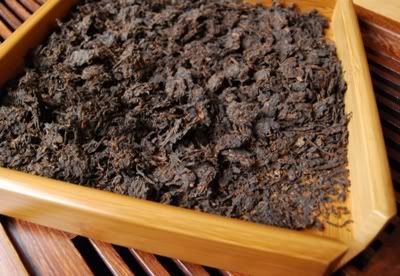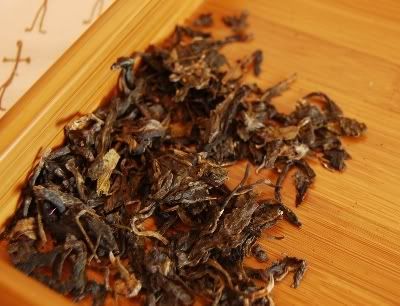I tend to shy away from clutter, as long-time readers may remember, and am constantly pruning away everything from unwanted teas, through unwanted pots, even to redundant tea-photographs. Owning a "specialist" tool that fulfills a single, infrequently-executed function isn't really my preference.
The pu'er tray (pictured below) first came to my attention when Yunnan Sourcing started selling them back in 2005-06. The description read something like "impress your friends with a bit of teaware that only you know how to use". Needless to say, this didn't really excite me.
There it stayed until Lei and I were drinking with Norpel, and he mentioned that it was among the most useful items of teaware that he owned. Gradually convinced, I finally bought my own, and have found it to be a genuine pleasure.
The pu'er tray (pictured below) first came to my attention when Yunnan Sourcing started selling them back in 2005-06. The description read something like "impress your friends with a bit of teaware that only you know how to use". Needless to say, this didn't really excite me.
There it stayed until Lei and I were drinking with Norpel, and he mentioned that it was among the most useful items of teaware that he owned. Gradually convinced, I finally bought my own, and have found it to be a genuine pleasure.
Of course, its primary purpose to to avoid spilling pu'er, and to make breaking a cake a little safer. (Pictured above: breaking apart a shu bing for office drinking.) These are handy functions, but I didn't quite appreciate how useful it could be until I started actually using it.
For me, it's greatest benefit is that it allows the sorting of the leaves very easily: gently incline the tray, and shake it. The fannings slide to the bottom, the larger leaves remain at the top.
For me, it's greatest benefit is that it allows the sorting of the leaves very easily: gently incline the tray, and shake it. The fannings slide to the bottom, the larger leaves remain at the top.
If you're one of those types that likes to include fannings and tiny segments with your infusion (usually in order to beef up the first brew), this probably isn't for you. However, I seldom find a need for such fragments, and prefer to have them removed in order to reduce bitterness. The pu'er tray's simple sifting property (a little like panning for gold) allows me to easily draw off the whole leaves, leaving the fannings behind.
I have since started a collection of my pu'er leftovers in a little pot. It's a handy mechanism, as it also allows you to filter the loose leaves that accumulate in wrappers - my wrappers are now clean, because I empty them out into the tray along with the bing when preparing tea for a new session.
I wonder what the collected residuum will be like? It certainly smells rich and complex, being comprised of so many different cakes...
I have since started a collection of my pu'er leftovers in a little pot. It's a handy mechanism, as it also allows you to filter the loose leaves that accumulate in wrappers - my wrappers are now clean, because I empty them out into the tray along with the bing when preparing tea for a new session.
I wonder what the collected residuum will be like? It certainly smells rich and complex, being comprised of so many different cakes...



6 comments:
I think what you have in that pot is known as Bai Dah Cha Shan. Haha. We tried a mixture of tea fannings and leftovers before and it was complex indeed. The first brew was really strong because of the fannings and was a challenge to pour out the tea fast. The taste is strange as it is and will definitely give you a caffeine ride. Good luck. :)
--ST
happy to see you've found the joys of a pu'er tray... forever more your carpets will be clean :)
I find the tray useful too. I picked one up at a local tea store last Spring. I have significantly reduced stray tea fragments from invading my living quarters.
I use my tray to pry off small chunks at a time for gong-fu cha. I use both chunks and fragments, though sometimes I'll dump fannings into a debris vessel (both shu and sheng). The taste is strange, body of shu and mouth feel and hui gan of sheng... complex indeed.
Unfortunately, about a month after owning it, a hairline fracture spontaneously emerged down the middle of the tray. It does not affect its function though.
The tray is especially useful for those Xiaguan cakes, like Nan Zhou.
Cool pics.
Dear Seb,
I bet it'll be potent, just as you say - I'm sure I've seen little bags for sale in which you can put your own tea. I can create a semi-decent pu'er teabag. :)
Dear Nada,
Thanks again for the pointer - I had entirely written these trays off!
Dear Ecclenser,
I'm sorry to hear you've got a split - such is the way of bamboo!
Those iron-pressed cakes really benefit from these trays, yes indeed - I'd forgotten to mention that. My fingers bleed much less frequently, these days...
Toodlepip,
Hobbes
It is so funny that you mentioned the idea of combining fannings. I have been toying with the idea for about a week now and was about to shoot you off an email to see what you thought. this should be interesting!
Dear Jason,
Great minds think alike!
Or fools seldom differ. :)
Toodlepip,
Hobbes
Post a Comment